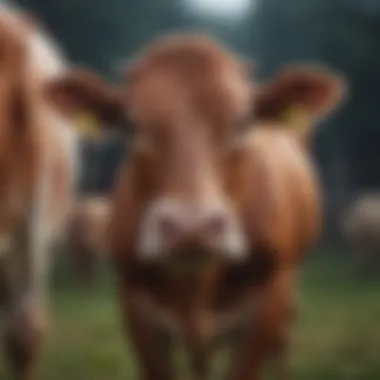Melatonin Implants in Cattle: Benefits and Applications


Intro
Melatonin implants in cattle have gained attention as a strategy to enhance livestock management. The focus on improving animal health and productivity aligns with modern agricultural trends. Melatonin is a hormone that regulates sleep-wake cycles in animals, and its supplementation through implants can influence various physiological processes in cattle.
This article will dive into the applications and benefits of melatonin implants in cattle. We will explore how they can enhance reproductive cycles, improve growth rates, and impact meat quality. Understanding the implications of melatonin use is essential for farmers and researchers aiming to optimize management strategies.
Research Highlights
Key Findings
Recent studies indicate that melatonin implants can significantly affect cattle reproductive processes. The hormone helps synchronize estrus cycles, leading to better breeding outcomes. Additionally, these implants have shown potential in improving feed efficiency and growth rates. Researchers have noted that cattle receiving melatonin implants exhibit better overall muscle quality. This has implications for meat tenderness and flavor, which are critical factors in consumer satisfaction.
Implications and Applications
The use of melatonin in cattle management holds promise for addressing several challenges. Farmers can employ these implants to better control reproductive timing. This helps in planning mating and calving schedules, ultimately improving productivity.
From an economic perspective, enhancing meat quality can lead to higher market prices. As consumers become more discerning, the demand for quality products increases. Therefore, incorporating melatonin implants into husbandry practices offers a viable path to meet consumer expectations and enhance farm profitability.
"The integration of melatonin implants in cattle management exemplifies the innovative approaches needed for modern agriculture."
Methodology Overview
Research Design
Most studies on melatonin use in cattle involve controlled trials. These trials compare groups receiving melatonin implants against control groups without implants. The primary objective is to evaluate various performance metrics over a defined period.
Experimental Procedures
In typical experimental setups, cattle are divided based on age and breeding history. Melatonin implants are administered at specific intervals, and parameters such as estrus synchronization, growth rate, and meat quality are measured. Research often employs various statistical methods to analyze differences between groups, ensuring robust findings.
Preamble to Melatonin in Animal Agriculture
The significance of melatonin in animal agriculture has gained growing attention in recent years. Melatonin is a hormone that plays a vital role in regulating circadian rhythms and seasonal reproductive patterns in various species, including cattle. Understanding its functions and applications can lead to improved livestock management practices and overall herd performance. This article focuses on melatonin implants and their potential benefits for cattle, setting the context for deeper exploration of specific applications and advantages.
Overview of Melatonin
Melatonin, primarily known for its role in sleep regulation, is produced in the pineal gland of mammals. In cattle, the secretion of melatonin is influenced by light exposure. During shorter daylight hours, typically in the winter months, melatonin levels rise. This increase signals physiological changes that align with breeding and growth cycles.
The importance of melatonin extends beyond sleep. It also impacts reproductive hormones like cortisol and luteinizing hormone. Thus, its modulation can trigger reproductive readiness, synchronize breeding cycles, and affect growth patterns. Melatonin refers not just to a hormone but a key element in aligning biological rhythms in livestock, ensuring optimal health and productivity.
Importance of Melatonin in Livestock
The application of melatonin in livestock is critical for several reasons. Firstly, it helps in synchronizing estrus cycles, a crucial factor for breeding efficiency. By manipulating melatonin levels, farmers can induce heat in cattle, allowing for more effective artificial insemination practices. This ensures a higher pregnancy rate and reduces the time needed for successful breeding.
Secondly, melatonin contributes to improved growth rates. Cattle given melatonin implants tend to exhibit enhanced weight gain and feed efficiency. This leads to better meat quality, which is increasingly important in a competitive market.
Additionally, stress reduction is another substantial benefit associated with melatonin treatment. Cattle experience various stressors during handling, transportation, and environmental changes. Melatonin can help alleviate some of these stress responses, resulting in healthier and more productive animals.
> "The integration of melatonin in cattle breeding and management practices represents a significant advancement in animal husbandry."
In summary, melatonin is not merely a hormone; it is a pivotal player in livestock productivity. By understanding its mechanisms and applications, producers can make informed decisions that align with modern practices in cattle management.
Biochemistry of Melatonin
The biochemistry of melatonin plays a crucial role in understanding its applications in cattle management. Melatonin is a hormone primarily produced by the pineal gland in the brain, and it serves various physiological functions. Its synthesis and release are influenced by light exposure. This section delves into the mechanisms that govern its production and the receptors through which it acts in cattle, forming the foundation for its benefits in livestock.
Synthesis and Release Mechanisms
Melatonin is synthesized from the amino acid tryptophan through a series of enzymatic reactions. The first step involves the conversion of tryptophan to serotonin, which is then converted into melatonin. The final production of melatonin peaks during the night, closely correlated to darkness and light cycles. This natural rhythm is vital for regulating circadian cycles and seasonal reproductive patterns in cattle.


As darkness falls, norepinephrine is released, stimulating melatonin synthesis. Conversely, exposure to light inhibits its production. This regulation hints at its potential applications in managing reproductive timings and growth cycles in cattle, particularly in environments where natural light cycles may be compromised.
Melatonin Receptors in Cattle
Once released, melatonin binds to specific receptors in the body, primarily MT1 and MT2 receptors. These receptors are distributed throughout various tissues and play vital roles in communicating the signals initiated by melatonin. For example, the MT1 receptor is significantly involved in the modulation of reproductive hormones such as luteinizing hormone (LH), which governs reproductive functions in cattle.
Understanding the location and function of these receptors allows farmers and researchers to tailor melatonin treatments effectively. Recent studies suggest that improving reproductive efficiency through melatonin could lead to higher reproductive success rates and better herd management. Insights regarding receptor distribution contribute to optimized dosage and administration strategies, further enhancing the effectiveness of melatonin implants.
"Melatonin's influence on receptor activity highlights its critical role in regulating both growth and reproduction in cattle."
By comprehending the biochemistry of melatonin, stakeholders in animal agriculture can leverage its potential benefits. The manipulation of melatonin synthesis and receptor engagement offers promising avenues for enhancing livestock performance and welfare.
Mechanisms of Action in Cattle
Understanding the mechanisms of melatonin's action in cattle is crucial for grasping its impact on animal performance. Melatonin plays a significant role in regulating various biological processes. Its effects on reproductive cycles and growth development form the backbone of its importance in cattle management.
Regulation of Reproductive Cycles
Melatonin primarily influences reproductive cycles in cattle through modulation of reproductive hormones. The hormone is produced in response to darkness, signaling the animal's body about the time of the year. It affects the secretion of gonadotropin-releasing hormone (GnRH), which in turn regulates the release of luteinizing hormone (LH) and follicle-stimulating hormone (FSH).
Benefits of melatonin in reproductive regulation include:
- Synchronization of estrus cycles.
- Enhancement of conception rates.
- Longer breeding seasons.
These factors can lead to improved productivity and efficiency in breeding programs. Studies have indicated that the use of melatonin implants can advance the timing of estrus, thereby optimizing breeding schedules. Moreover, by adjusting melatonin levels, farmers can potentially increase the fertility of cattle during less favorable seasons.
Melatonin implants have been shown to effectively regulate reproductive cycles in a range of livestock species, including cattle, leading to higher reproductive success.
Impact on Growth and Development
In addition to its role in reproduction, melatonin significantly impacts growth and development in cattle. The hormone affects metabolism and enhances nutrient absorption, critical for healthy growth. It is associated with improved feed efficiency and weight gain.
Key aspects of melatonin's impact on growth include:
- Modulation of growth hormone secretion.
- Improvement in muscle-to-fat ratio.
- Promotion of bone growth.
Research indicates that cattle treated with melatonin implants experience enhanced growth rates compared to untreated cattle. This growth promotion can be particularly beneficial in calf rearing and in finishing cattle for market. Cattle with optimized growth profiles tend to fetch better prices at sale, making this aspect appealing for producers.
In summary, both reproductive and growth mechanisms of melatonin highlight its multifaceted role in cattle management. Farmers and livestock producers can leverage these insights to improve breeding strategies and overall herd performance. The understanding of these mechanisms provides a solid foundation for examining the broader applicability of melatonin implants in cattle management.
Application of Melatonin Implants
Melatonin implants present an innovative approach to cattle management. Their application can significantly influence various aspects of livestock production, particularly reproduction, meat quality, and stress management. Understanding the specific elements involved in administering these implants is crucial for maximizing their benefits.
Administration Techniques
The proper administration of melatonin implants is essential for achieving the desired outcomes in cattle management. Implants are typically inserted subcutaneously in the ear or under the skin. This method is favored for its convenience and effectiveness. Care should be taken to properly disinfect the area before insertion to minimize the risk of infection.
Several techniques can be used during the implantation process:
- Use of Implants: A standard implantation device can facilitate the process. It ensures consistent depth and placement.
- Handling the Cattle: Restraining the animal with proper handling techniques reduces stress during the procedure, which could affect the outcomes.
- Post-implantation Monitoring: After administering the implant, monitoring the cattle for any adverse reactions is advisable. Observing the animal’s behavior and health can provide insight into the effectiveness of the implant.
Implementing specific protocols can lead to successful outcomes, making careful administration indispensable.
Dosage Recommendations
Finding the correct dosage of melatonin is vital for optimal results in cattle. Factors such as age, weight, and specific health conditions must inform dosage decisions. Generally, a range of 18 to 30 mg per animal is considered appropriate for various applications.
Key considerations for dosage include:
- Age of Cattle: Young calves might require lower doses due to their size and development stage.
- Reproductive Goals: Different reproductive objectives may necessitate varying dosages.
- Monitoring Responses: Tracking the cattle's responses to the implant is crucial. Adjustments may be needed based on observed efficacy and any side effects.


General Guidelines:
- Assess the specific needs of the herd.
- Refer to manufacturer recommendations for the particular product used.
- Consult with a veterinarian to ensure best practices are being followed.
Effective dosage can greatly enhance the desired benefits of melatonin, whether it is for improving reproductive performance or enhancing overall health.
Implementing a careful approach in administration and dosage will help farmers and producers optimize the use of melatonin implants in cattle management. The focus should always remain on the well-being of the livestock while pursuing production goals.
Advantages of Melatonin Treatment
Melatonin treatment in cattle presents several profound advantages that significantly impact livestock management and overall productivity. The integration of melatonin implants into animal husbandry practices has piqued interest due to their multifaceted benefits, including enhancements in reproductive performance, meat quality, and stress reduction among livestock. The understanding of these benefits can assist farmers and producers in making informed decisions, thereby promoting better animal welfare and optimizing yield.
Enhancement of Reproductive Performance
The administration of melatonin implants can lead to substantial improvements in reproductive performance in cattle, particularly in reproductive efficiency and timings. Melatonin plays a regulatory role in reproductive cycles, often associated with light exposure. In situations where seasonal breeding occurs, melatonin can help synchronize estrous cycles, enabling cattle to breed more efficiently.
Under conditions where natural light cycles may be disrupted, such as indoor housing, melatonin serves as a tool to manage breeding intervals effectively. By mimicking the natural light cycle, it aids in optimizing fertility rates and can reduce the calving intervals.
- Melatonin helps regulate the secretion of reproductive hormones, such as luteinizing hormone.
- This regulation leads to increased estrus synchronization, improving overall breeding management.
- Enhanced fertility rates are particularly important in high-yield production systems.
Improvement of Meat Quality
Improving meat quality through the use of melatonin implants has shown promising results. Melatonin's impact on meat characteristics—such as tenderness, juiciness, and color—can be particularly beneficial for market acceptance.
Research indicates that melatonin may influence muscle development and growth, leading to more favorable meat attributes. Better muscle growth can lead to enhanced marbling and fat distribution, crucial factors driven by consumer preference. The ability to improve meat quality not only benefits producers through higher market prices but also meets consumer demands for superior quality.
- Studies reveal that melatonin can affect postmortem muscle metabolism, thus optimizing tenderness.
- Improved meat quality can result in lower wastage and increased profitability for producers.
Stress Reduction in Livestock
Stress is a known detriment to animal health and production. The use of melatonin implants is associated with stress reduction in cattle, which can lead to numerous beneficial outcomes, including improved feed conversion rates and enhanced immune response.
Melatonin has been recognized for its role in promoting relaxation and inducing sleep in animals, which is essential for recovery from various stressors—be it environmental changes, handling, or transportation. Reducing stress levels in cattle can lead to better health and wellbeing, resulting in decreased incidence of metabolic disorders and higher overall productivity.
- A calmer animal is easier to manage, thereby reducing handling risks.
- Improved wellbeing leads to higher weights at slaughter, thus increasing profitability.
"The thoughtful application of melatonin implants can vastly improve herd management, offering remarkable benefits that go beyond mere biological efficiency."
Challenges and Limitations
When considering melatonin implants for cattle, it is essential to address the challenges and limitations associated with their use. Understanding these factors is crucial for farmers and researchers alike, as it influences the overall effectiveness and acceptance of this treatment in livestock management. While melatonin has demonstrated many benefits, there are specific concerns that must be thoroughly examined to ensure responsible application in animal agriculture.
Potential Side Effects
Melatonin implants can produce various side effects in cattle. These effects may vary based on individual animal responses, dosage, and administration methods. Some reported side effects include:
- Drowsiness: Animals may exhibit increased sleepiness, which can affect their activity levels.
- Hormonal Imbalances: Altered levels of other hormones may result, leading to unintended reproductive or growth issues.
- Behavioral Changes: Some cattle may show unexpected behaviors, potentially altering social dynamics within herds.
- Local Reactions: There may be mild local tissue reactions at the injection site, including swelling or discomfort.
While not all cattle experience side effects, it is critical to monitor animals closely post-administration. Understanding individual variations and the potential for adverse effects plays a vital role in making informed decisions about melatonin use in cattle.
Regulatory Concerns
The regulatory landscape surrounding melatonin use in cattle varies by region. In many areas, melatonin is classified as a drug, which requires compliance with specific guidelines before it can be prescribed or administered. Key components of these regulations include:
- Approval Status: Some jurisdictions may not recognize melatonin for veterinary use, which restricts its implementation in livestock.
- Dosage Protocols: Regulations often dictate recommended dosages and administration protocols to ensure animal safety and consistent outcomes.
- Withdrawal Times: For animals intended for slaughter, understanding the withdrawal times for melatonin is crucial to ensure that no residues remain in meat products.
- Labeling Requirements: Compliance with proper labeling and record-keeping can be burdensome but is necessary for tracing and accountability in livestock treatment.
Addressing these regulatory concerns is vital for assuring consumers of the meat quality and safety. Thus, familiarity with local guidelines is imperative for farmers wishing to incorporate melatonin implants into their management practices.
Field Studies and Research Insights
Field studies and research insights play a critical role in understanding the practical applications and effectiveness of melatonin implants in cattle. This section delves into essential elements of this topic, focusing on the contributions of research findings to enhancing cattle management practices.


The influence of melatonin on cattle performance has been the subject of numerous studies. Understanding these findings helps farmers and researchers grasp the potential advantages of melatonin implants. By drawing connections between scientific research and real-world applications, this section aims to present data that support the use of melatonin in improving livestock health and productivity.
Review of Key Research Findings
Research has shown melatonin implants can significantly influence cattle physiology and behavior. Various studies highlight the positive effects of melatonin on reproductive performance and overall herd health. For instance, a study published in the Journal of Animal Science found that melatonin implants improved the reproductive efficiency of beef cows, leading to higher conception rates and increased calving frequency.
Another important aspect is the impact of melatonin on growth rates. Research from agricultural universities has confirmed that melatonin can enhance feed conversion efficiency. This results in healthier animals that reach market weight sooner, thus benefiting producers financially. Furthermore, studies suggest that melatonin can play a role in reducing stress levels in cattle, which can ultimately lead to better health outcomes.
"Understanding the impact of melatonin through comprehensive research enables more informed decisions in cattle management."
Case Studies and Practical Applications
Real-world case studies illustrate the practical applications of melatonin implants in various farming operations. One notable example involved a dairy farm in Wisconsin where the integration of melatonin implants led to measurable improvements in both reproductive success and milk production.
In this case, the farmers noted:
- Increased estrous activity in cows
- Higher milk yields per cow after implantation
- Reduction in calving complications
These observations were consistent with findings from experimental research, reinforcing the value of melatonin treatments in practical settings. Another case study from a beef cattle operation in Texas demonstrated that using melatonin implants during the breeding season resulted in enhanced calf viability and greater weaning weights.
These examples underscore not just the theoretical benefits, but also the tangible, practical applications of melatonin in various agricultural environments. As research continues, ongoing field studies will likely provide further insights, refining melatonin's applications and optimizing cattle production strategies.
Future Directions in Melatonin Research
Melatonin research in cattle is evolving. Understanding its potential benefits and applications is essential for improving livestock management. This section highlights future research pathways, emphasizing new delivery systems and additional applications. Focusing on these areas can lead to advancements in cattle health, productivity, and welfare.
Innovations in Delivery Systems
Innovative delivery systems for melatonin are key for enhancing its effectiveness. Current methods, such as injections and implants, are common but can be improved.
New approaches include:
- Transdermal patches: These offer consistent melatonin release and ease of administration. They may enhance compliance in veterinary practices.
- Oral formulations: Developing palatable feed additives could simplify administration. This method may increase acceptance among cattle and ensure precise dosing.
- Smart delivery systems: Incorporating technology can optimize dosage based on individual needs. For instance, wearable sensors could provide real-time monitoring of hormone levels.
Such innovations could revolutionize how melatonin is used in cattle, increasing its efficacy and reducing labor costs.
Exploration of New Applications
Exploring new applications of melatonin can broaden its benefits in animal agriculture. While reproductive performance and meat quality have been extensively studied, other areas remain under-researched.
Potential applications include:
- Immune function: Research shows melatonin may enhance immunity. Understanding its role in disease resistance could help develop healthier herds.
- Calmness and stress reduction: Melatonin's effects on behavioral traits could be beneficial in managing stress in cattle. This can improve overall welfare.
- Growth enhancements: Investigating melatonin's influence on growth rates and feed efficiency may lead to more sustainable practices in beef production.
By examining these new applications, further understanding can emerge, leading to more comprehensive cattle management strategies.
"The future of melatonin use in cattle hinges not just on existing applications, but also on the innovation of systems that deliver this crucial hormone effectively."
Closure and Implications for Cattle Management
Understanding the role of melatonin implants in cattle management is crucial for modern livestock production. These implants have demonstrated significant benefits, influencing reproductive performance, meat quality, and overall herd health. As farmers and producers aim for greater efficiency in their operations, incorporating melatonin as a part of their management strategies offers them a tool to enhance productivity while potentially reducing costs associated with reproductive issues and stress.
Summary of Key Benefits
Melatonin implants provide several advantages for cattle:
- Enhancements in Reproductive Cycles: They synchronize breeding cycles, improving conception rates and reducing the need for hormone treatments. This leads to more predictable calving patterns.
- Meat Quality Improvement: Studies suggest that melatonin can contribute to better meat grades and tenderness, appealing to higher market demands.
- Stress Reduction: The calming effects of melatonin help cattle cope with various stressors, including transport and environmental changes, leading to better overall well-being.
Recommendations for Farmers and Producers
For farmers and producers considering melatonin implants, the following recommendations can guide proper use:
- Consult with Veterinarians: Before implementing melatonin, discuss with a qualified veterinarian to evaluate its appropriateness for your herd.
- Monitor Dosage: Adhere strictly to dosage recommendations based on specific needs; improper use can lead to the diminished benefits.
- Evaluate Herd Response: Implement a monitoring system to assess changes in reproduction and overall health post-implantation. This helps in adjusting strategies for maximum effectiveness.
Integrating melatonin in cattle management is not just about productivity; it is about enhancing the quality of life for livestock and guaranteeing sustainability in farming practices.
By focusing on these aspects, cattle management can shift towards a more scientifically informed approach that benefits both the animals and the producers.



